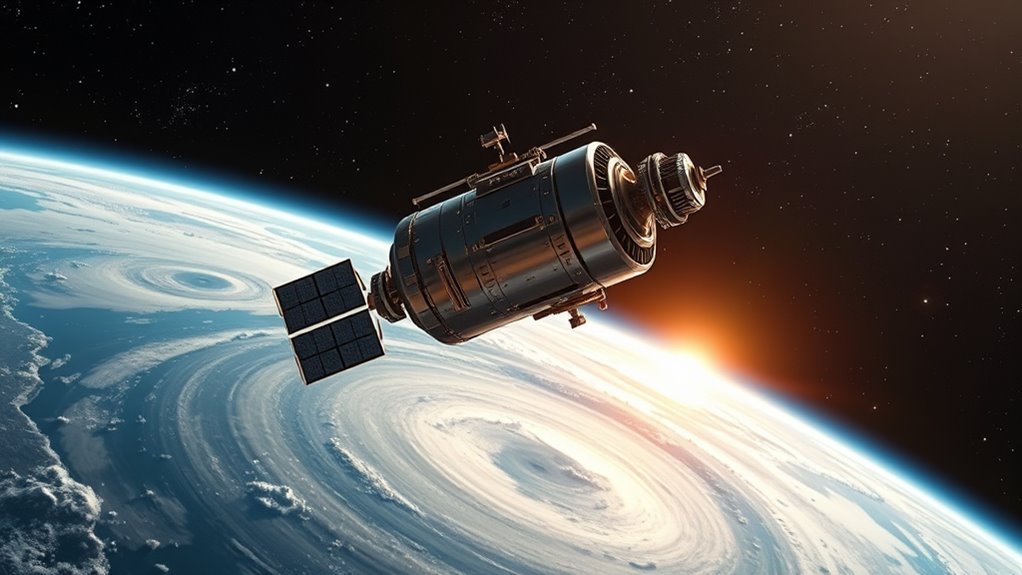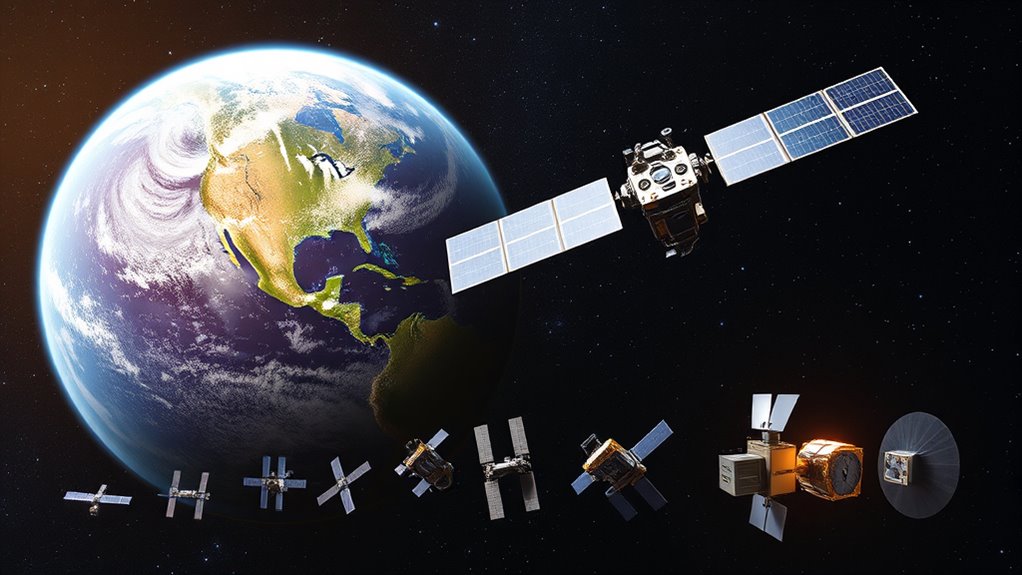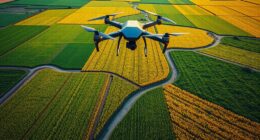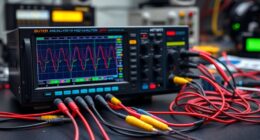Over the past 60 years, spy satellites have evolved from basic surveillance tools into highly intelligent systems. You’ve seen how early satellites relied on manual control and simple automation, and how advances in AI enabled onboard data analysis, autonomous navigation, and real-time monitoring. Today’s smart satellites can adapt, troubleshoot, and process data independently, boosting security and efficiency. If you keep exploring, you’ll discover even more about how AI continues to shape space technology’s future.
Key Takeaways
- Early satellites relied on manual control and rule-based AI for reconnaissance and communication.
- Onboard data analysis and machine learning enabled faster, autonomous decision-making in satellites.
- Transitioned from basic automation to autonomous navigation, troubleshooting, and orbit optimization.
- Advanced AI analytics facilitated real-time monitoring, anomaly detection, and environmental tracking.
- Future satellites will be smarter, adaptive, and secure, enhancing autonomous operations and societal benefits.

Over the past 60 years, artificial intelligence has transformed how satellites operate and serve us. When you look up at the sky, it’s hard to imagine that behind those tiny blinking lights are machines that have evolved from simple tools into sophisticated sentinels powered by AI. In the early days, satellites were primarily used for military reconnaissance and communication, relying on manual control and basic automation. But as technology advanced, so did the potential of what satellites could do, especially with the infusion of AI, turning them into more autonomous and intelligent systems.
Initially, AI’s role in satellites was limited to assisting ground control with data processing and image analysis. You might not realize it, but early AI algorithms helped interpret satellite images faster and more accurately, aiding in weather forecasting and intelligence gathering. These systems were simple, often rule-based, but they laid the groundwork for more complex AI applications. As computing power grew, satellites started to incorporate machine learning techniques that allowed them to analyze data onboard, reducing the need for constant communication with Earth and enabling faster decision-making. This shift meant that satellites could now adapt to changing conditions, identify objects of interest, and prioritize data collection without human intervention.
Early AI in satellites improved image analysis and decision-making, paving the way for autonomous space operations.
Over time, AI transformed satellites from mere passive observers to active participants in their missions. Today, you see satellites that can autonomously navigate around space debris, optimize their orbit for better coverage, and even troubleshoot technical issues without waiting for commands from Earth. This level of autonomy substantially enhances their operational lifespan and reliability. Furthermore, AI-driven analytics enable real-time processing of vast amounts of data, making it possible to detect anomalies, monitor environmental changes, or track moving objects with incredible precision. This evolution has opened new possibilities for disaster response, climate monitoring, and national security.
The journey from basic automation to intelligent, self-sufficient satellites reflects a broader trend in technological innovation. You benefit from this evolution every day, whether through improved weather forecasts, GPS accuracy, or secure communications. As AI continues to develop, satellites will become even more capable, learning from their environment and improving their performance over time. The integration of AI security measures ensures that these systems remain safe and resilient against potential threats. The future promises smarter, more adaptive satellites that can handle complex tasks independently, ultimately making space operations safer, more efficient, and more beneficial for everyone. Your understanding of satellite technology has grown, but the true story is how AI has continuously pushed the boundaries, transforming these celestial devices from simple tools into intelligent partners that serve you better each day.
Frequently Asked Questions
How Has AI Improved Satellite Data Analysis Over the Decades?
AI has markedly enhanced your satellite data analysis by enabling faster and more accurate processing of vast data sets. You benefit from machine learning algorithms that identify patterns and anomalies, reducing human effort. AI improves image resolution, automates target detection, and predicts future events. With AI, your satellite systems become smarter, more efficient, and capable of delivering timely insights, ultimately transforming how you monitor and respond to global changes.
What Are the Future AI Advancements Expected in Satellite Technology?
You can expect AI to make satellites more autonomous, enabling real-time decision-making and adaptive operations. Future advancements include improved image recognition, predictive maintenance, and enhanced data compression. AI will also help satellites better analyze complex environmental data, supporting climate monitoring and disaster response. As a result, you’ll see smarter satellites that provide faster, more accurate insights, transforming how we monitor Earth and space.
How Do AI Satellites Impact Global Security and Privacy?
AI satellites markedly impact global security and privacy by enhancing surveillance capabilities and data analysis. You might find that they improve threat detection and response times, but they also raise concerns about invasive monitoring and data misuse. As you rely more on these smart systems, it’s essential to balance national security benefits with protecting individual privacy rights, ensuring responsible use and robust regulations.
What Challenges Face AI Integration in Satellite Systems Today?
You face several challenges when integrating AI into satellite systems today. Data security and privacy are major concerns, as sensitive information must be protected from cyber threats. Ensuring reliable, real-time processing with limited onboard resources is tough. Additionally, addressing ethical issues and gaining regulatory approval can slow deployment. Balancing innovation with security and compliance demands careful planning to overcome these hurdles and maximize AI’s potential in satellite technology.
How Do AI Satellites Collaborate With Ground-Based Intelligence Networks?
You can see AI satellites collaborating with ground-based intelligence networks by sharing real-time data and insights seamlessly. They automatically analyze images, signals, and sensor information, then transmit relevant findings to analysts on the ground. This collaboration enhances situational awareness, speeds up decision-making, and improves mission accuracy. You benefit from faster responses and more accurate intelligence, as AI-driven satellites and ground networks work together to provide all-encompassing, up-to-date information for strategic use.
Conclusion
Your journey through 60 years of AI satellites is like watching a seed blossom into a mighty tree, transforming from spy satellites to smart, autonomous systems. You’ve seen how technology evolves, shaping the future of surveillance and communication. As AI continues to grow, this story isn’t just history; it’s a launchpad for even more groundbreaking advances. Keep your eyes on the sky — the next chapter promises to be even more extraordinary.








